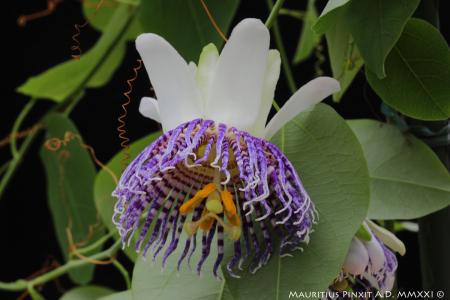
SUBGENUS: passiflora
SUPERSECTION: stipulata
SECTION: granadillastrum
GEOGRAPHICAL DISTRIBUTION OR ORIGIN:
Southeast Brazil.
MINIMUM TEMPERATURE: -2 °C
IDEAL MINIMUM TEMPERATURE: 5 °C
SYNONYMS: P. paulensis Killip.
ETYMOLOGY: It is due to the appearance of the flower which recalls that of the sea anemone (Attinia). The etymology is taken from the Greek ἀκτῖνος (actinos) which means, 'ray', 'rays of the sun'.
NOTES: Flowering period in my collection: January and February in a heated greenhouse. I therefore believe it is a short-day species.
USDA Zones: 8 -11.
Chromosomes: 2n=18
DESCRIPTION:
In the flower of this passiflora there is a strong contrast between the corolla formed by the petals and the white retroflex sepals and the large crown composed of 4 or 5 series of filaments, protruding forwards and coloured in violet, pink and white.
The flowers have a diameter of about 8-9 cm, flowering is generous and usually occurs in February-March, if the plant is sheltered in a warm greenhouse, otherwise in late spring.
It is a light climber that tends to become very dense thanks to the brevity of the internodes and the richness of the foliage. The leaves are whole, glaucous green, oval in shape, and widened at the base.
The sepals are white on the inside and green on the outside, while the petals are white on both surfaces. The crown of the filaments is so striking due to its colour with contrasting alternating bands that recall the characteristic crown of sea anemones. It extends forwards, almost hiding the stigmas and anthers. The fruits are small, spherical, yellow when ripe and contain a fragrant aril in which numerous black seeds are immersed.
P. actinia comes from the mountainous areas of Brazil. It is easy to grow in pots (at least 18-20 cm in diameter) and its graceful and lively appearance makes it a very popular plant. If space is reserved for it, it can reach several metres in length and cover pergolas and walls with gratings.
It does not resist the winters of the Po Valley, where it is advisable to shelter it, but it adapts well outdoors in climatic areas with mild winters, such as Liguria, the lakes and the south, as it tolerates short frosts down to -5°C. Damage can be limited by protection to the crown and foot and by placing it in sheltered places.
The flowering of exceptional beauty and its relative hardiness make it an interesting plant to grow in the home or outdoors depending on the season and climate of your region.
It requires light soil and regular, not excessive watering. Reproduction is obtained by seed and cutting. The latter method is preferable since larger plants are obtained in less time.